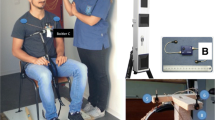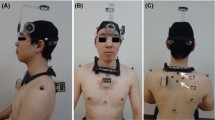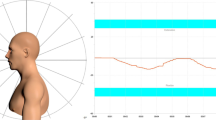Abstract
The authors investigated the effect of neck dimension upon cervical range of motion. Data relating to 100 healthy subjects, aged between 20 and 40 years, were recorded with respect to age, gender and range of motion in three planes. Additionally, two widely used methods of measuring neck motion, chin-sternal distance and uniplanar goniometer, were assessed against a validated measurement tool, the ‘CROM goniometer’. Using multiple linear regression analysis it was determined that sagittal flexion (P = 0.002) and lateral rotation (P < 0.0001) were most closely related to neck circumference alone whereas lateral flexion (P < 0.0001) was most closely related to a ratio of circumference and length of neck. Hence, assessing cervical range of motion as outcome variable or as a measure at posttreatment follow-up, neck circumference was shown to be one of the factors influencing total neck motion, particularly sagittal flexion and lateral tilt. Comparison of cervical range of motion assessed with a validated measurement tool, the CROM goniometer, with results of both frequently applied clinician’s instruments, the uniplanar goniometer and measurement of chin-sternal distance, showed low reliability with the latter techniques, and motion values measured with these techniques should be interpreted with caution if using them for comparison of cervical range of motion of alike groups. We demonstrated that neck dimension should be incorporated into cervical functional outcome assessment and one should be wary about recorded values for neck motion from non-validated measurement tools.


Similar content being viewed by others
References
Alaranta H, Hurri H, Heliovaara M, Soukks A, Harju R (1994) Flexibility of the spine: normative values of goniometric and tape measurements. Scand J Rehabil Med 24:147–154
Antonaci F, Ghirmai S, Bono G, Nappi G (2000) Current methods for cervical spine movement evaluation: a review. Clin Exp Rheumatol 18:S45–S52
Armstrong B, McNair P, Taylor D (2008) Head and neck position sense. Sports Med 38:101–117. doi:10.2165/00007256-200838020-00002
Bovim G, Schrader H, Sand T (1994) Neck pain in the general population. Spine 19:1307–1309
Capuano-Pucci D, Rheault W, Aulai J, Bracke M, Day R, Pastrick M (1991) Intratester and intertester reliability of the cervical range of motion device. Arch Phys Med Rehabil 72:338–340
Castro WH, Sautmann A, Schilgen M, Sautmann M (2000) Noninvasive three-dimensional analysis of cervical spine motion in normal subjects in relation to age and sex. An experimental examination. Spine 25:443–449. doi:10.1097/00007632-200002150-00009
Chen J, Solinger A, Poncett F, Lantz C (1999) Meta-analysis of normative cervical motion. Spine 24:1571–1578. doi:10.1097/00007632-199908010-00011
Christensen H, Nilsson N (1999) The ability to reproduce the neutral zero position of the head. J Manipulative Physiol Ther 22:26–28. doi:10.1016/S0161-4754(99)70102-8
Cote P, Cassidy JD, Carroll L (2000) The factors associated with neck pain and its related disability in the Saskatechewan population. Spine 25:1109–1117. doi:10.1097/00007632-200005010-00012
Demaille-Wlodyka S, Chiquet C, Lavaste J-F, Skalli W, Revel M, Poiraudaeau (2007) Cervical range of motion and cephalic kinesthesis—ultrasonographic analysis by age and sex. Spine 32:E254–E261. doi:10.1097/01.brs.0000259919.82461.57
Feipel V, Rondelet B, Le Pallec J-P, Rooze M (1999) Normal global motion of the cervical spine: an electrogoniometric study. Clin Biomech (Bristol, Avon) 14:462–470. doi:10.1016/S0268-0033(98)90098-5
Hole DE, Cook JM, Bolton JE (1995) Reliability and concurrent validity of two instruments for measuring cervical range of motion: effects of age and gender. Man Ther 1:36–42. doi:10.1054/math.1995.0248
Jordan K (2000) Assessment of published reliability studies for cervical spine range-of-motion measurement tools. J Manipulative Physiol Ther 23:180–195. doi:10.1016/S0161-4754(00)90248-3
Kasch H, Stengaard-Pedersen K, Arendt-Nielsen L, Staehelin Jensen T (2001) Headache, neck pain, and neck mobility after acute whiplash injury: a prospective study. Radiologic, and psychosocial findings. Spine 26(11):1246–1251
Makela M, Heliovaara M, Sievers K, Impivaara O, Knekt P, Aromaa A (1991) Prevalence, determinants, and consequences of chronic neck pain in Finland. Am J Epidemiol 134:1356–1367
Nilsson N (1995) Measuring passive cervical motion: a study of reliability. J Manipulative Physiol Ther 18:293–297
Nilsson N, Christinse HW, Hartvigsen J (1996) The interexaminer reliability of measuring passive cervical range of motion, revisited. J Manipulative Physiol Ther 19:302–305
Platzer P, Thalhammer G, Ostermann R, Wieland R, Vecsei V, Gaebler C (2007) Anterior screw fixation of odontoid fractures comparing younger and elderly patients. Spine 32:1714–1720. doi:10.1097/BRS.0b013e3180dc9758
Radonov BP, Dvorak J (1996) Impaired cognitive functioning after whiplash injury of the cervical spine. Spine 21:392–397. doi:10.1097/00007632-199602010-00029
Spitzer WO, Skovron ML, Salmi LR, Cassidy JD, Duranceau J, Suissa S, Zeiss E (1995) Scientific monograph of the Quebec task force on whiplash-associated disorders: redefining “whiplash” and its management. Spine 20:S1–S73
Squires B, Gargan MF, Bannister GC (1996) Soft tissue injuries of the cervical spine 15 year follow up. J Bone Joint Surg Br 78-B:955–957. doi:10.1302/0301-620X78B6.1267
Tousignant M, de Bellefeuille L, O’Donoughue S, Grahovac S (2000) Criterion validity of the cervical range of motion (CROM) goniometer for cervical flexion and extension. Spine 25:324–330. doi:10.1097/00007632-200002010-00011
Trott P, Pearcy M, Ruston S, Fulton I, Brien C (1996) Three-dimensional analysis of active cervical: the effect of age and gender. Clin Biomech (Bristol, Avon) 11:201–206. doi:10.1016/0268-0033(95)00072-0
Webb R, Brammah T, Lunt M, urwin M, Allison T, Symmons D (2003) Prevalence and predictors of intense, chronic, and disabling neck and back pain in the UK general population. Spine 28:1195–1202. doi:10.1097/00007632-200306010-00021
Youdas J, Garrett T, Suman V, Bogard C, Hallman H, Carey J (1992) Normal range of motion of the cervical spine: an initial goniometric study. Phys Ther 72:770–779
Acknowledgment
Dr Peter Williams, Department of Mathematics, Surrey University, Guildford.
Author information
Authors and Affiliations
Corresponding author
Rights and permissions
About this article
Cite this article
Reynolds, J., Marsh, D., Koller, H. et al. Cervical range of movement in relation to neck dimension. Eur Spine J 18, 863–868 (2009). https://doi.org/10.1007/s00586-009-0894-z
Received:
Accepted:
Published:
Issue Date:
DOI: https://doi.org/10.1007/s00586-009-0894-z




